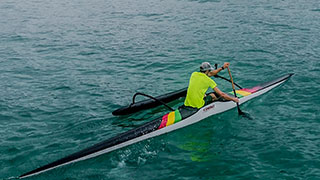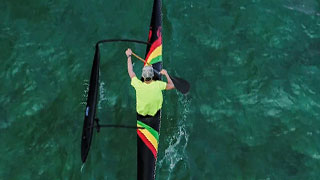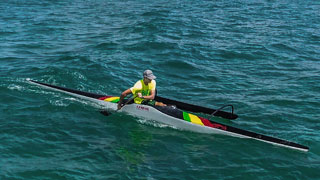“We've taken everything we've learned from oc1 canoes and sixman canoes and put that knowledge into the Ka'iwa.”
-Kamanu Composites Design TeamThe Ka'iwa
We believe that the beauty of V1 paddling comes from the connection between the stroke, the canoe, and the ocean. To maintain control without a rudder your stroke is being continuously formed by the ocean. And va’a design is forged out of this interaction between the paddler and the water. What makes a canoe go fast doesn’t make it go straight; what makes a canoe go straight doesn’t make it responsive in the surf; and what makes a canoe responsive in the surf doesn’t make it go fast. Rudderless design is a balance between these three competing features. While there is no perfect V1 for every condition and paddler, we think the Ka'iwa is the most well rounded canoe on the water.
VS the Aukahi
Designed and released in 2009, the Aukahi was our first V1. Because the Aukahi has very little rocker in the front, its long waterline makes it efficient in the flat water and its large midsection gives it the volume needed for rougher conditions. However, the volume and length also make it a bit unwieldy for many paddlers. While the long waterline through the nose helps gain speed and efficiency, it also gives the Aukahi a narrow window of control. The steering is stable for a 10-15 degree window, but once the bow of the canoe leaves that small window, the bow will often control the boat forcing you to either spin out or expend a lot of energy trying to hold it straight. Our goal with the Ka'iwa was to widen that window of control and to make a V1 that would be fast in all wind angles and ocean conditions.
Using our Pueo as a rough starting point, we modeled a hull that we knew was both efficient and could surf well. Then we started stretching it out to gain efficiency and control until our software based drag estimates stopped improving an appreciable amount. This left us with a length 6" shorter than the Aukahi and many other V1s. Getting the same flat water speed out of a shorter length comes with the added benefit of making the canoe more maneuverable, having less windage, and being able to fit better into an open ocean trough. We were also able to move both the center of buoyancy and weight of the paddler forward, which enables the canoe to drop in easier without sacrificing speed. The final improvement was to tighten up all the features on the deck to give it a lower profile than the Aukahi, so it’s less affected by cross winds.
The Ka’iwa is the best rudderless we know how to build, and we believe it’s the best all-around V1 on the water. But don't take our word for it! Get in touch with us to schedule a demo.
FAQ
What is a V1?
V1 stands for one-person va’a. The Tahitian term va’a is used to differentiate it from an OC-1 (one-person outrigger canoe). V1s are traditionally defined by an open cockpit and no rudder.
Is it hard?
Because you have to steer with your paddle, the V1 has a much steeper learning curve than the OC1. If the wind is blowing hard from the side, you may have to take 100 consecutive strokes on one side to compensate. When you’re trying to catch a wave it can be really difficult to simultaneous apply explosive power while turning the nose in the direction you need to go. And then when you drop in on the wave, you need to put all of your focus into keeping the canoe straight. But, the challenge and purity of steering with your paddle is also what make it so rewarding.
What conditions do V1s work best in?
The direction and speed of the wind determines whether a V1 a suitable. Because the hull is more efficient, an experienced V1 paddler can be faster in flat water and upwind than they would be on an OC-1. In straight downwind conditions, V1 paddlers are generally only slightly slower than their counterparts on an OC1 just because the canoe can be harder to connect between waves. As the wind comes more from the side, V1 paddling gets progressively more difficult because the canoe will always want to round up into the wind. Novice V1 paddlers should not go out on windy days or downwind runs until they have spent a lot of time on the canoe.
Where do people race V1s?
Other than Hawai’i, V1s are the dominant form of racing craft throughout Polynesia. They are also used exclusively in the IVF World Sprints and IVF World Distance Championships. There is also a growing contingent of dedicated V1 paddlers in Hawai’i who are entering each island’s OC1 series.
Does the open cockpit make it more dangerous?
In rough ocean conditions, the cockpit will take in water. All of our Ka’iwa come with a footpump that attaches to the footbrace which will allow you to suck water out with every stroke. While the footpump will keep the canoe dry in most ocean conditions, it is possible to fill up the cockpit after a huli. The canoe will always have positive buoyancy (because bulkheads seal off the bow and stern), but it is important to practice recovering from a huli to make sure that you are able to partially drain the canoe by pushing the cockpit upwards as you flip it over by back over. Even with a footpump, it is important to always bring a bailer with you.
Do you offer V1 lessons?
Yes! If you live on O’ahu or Kaua’i, contact us at info@kamanucomposites.com to schedule a V1 lesson.
Canoes in Stock
Ka'iwa Features
- Beam Over All: 16.25"
- Length Over All: 22' 10"
- Hull Weight: 20-23 lbs
- Ama Weight: 4 lbs
- Anodized Aluminum Iako
- Adjustable Footbrace
- Foot pump



Layup Options
- Performance: 23 lbs
- The deck has 4oz carbon on the outside, a 1/8" foam core, and a 3.9oz carbon on the inside. For added durability, the hull has two layers of 4.0oz S glass, a 1/8" foam core, and a 3.9 oz carbon on the inside. Recommended for customers where weight is a concern, but so is durability.
- Elite 22 lbs
- The hull and deck have a 4oz carbon on the outside, a 1/8" foam core, and a 3.9oz carbon on the inside. With only one layer of carbon on the outside of the hull, the canoe will dent and possibly fracture easier with impact. It is our lightest lay-up, but also the most fragile. So it is recommended for customers who consider weight a major factor. Customers who are looking for the lightest canoe possible can purchase a Team canoe that only comes in solid grey but is guaranteed to weigh under 21 lbs.
Spray Options and Pricing
- Simple custom: $5400
- Includes: Solid colors. Three color maximum.
- Complex custom: $5700
- Spray jobs are limited only by your imagination and our ability to spray. Abstract designs are ok, complex designs may need to be simplified. We can spray up to five colors on a canoe. Webbing, splatter, clear, and pearl type designs are all ok. Fades, pearl, and hard lines on the hull are possible, though not recommended. Clear on the deck is possible, but not on the hull. Any design that takes more than fourteen hours to spray or requires the use of of our CNC machine to cut out a custom stencil (like scales, diamonds, checkers, etc) will cost an additional $200.
How to Buy
There are two ways to purchase a Ka'iwa:
- Off-the-shelf canoes are available for purchase for anyone around the world. A current listing of available canoes is continuously updated at the Kamanu Store.
- Custom canoes built for you are available by a waitlist. To place an order, go to store.kamanucomposites.com. A $1000 deposit must be made at the time of order.
Questions?
Call us anytime (808) 228-8609, email info@kamanucomposites.com or reach out to one of our local reps listed below.
Local Reps
- Australia: Shon Siemonek
- Hong Kong/Singapore: Hong Kong
- Southern California: Corey Simpson
- Northern California: Ben McNeil
- Pacific Northwest: Alan Goto
